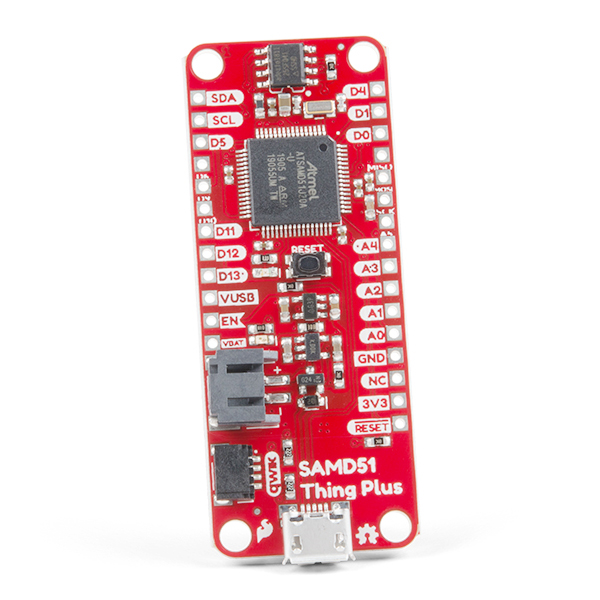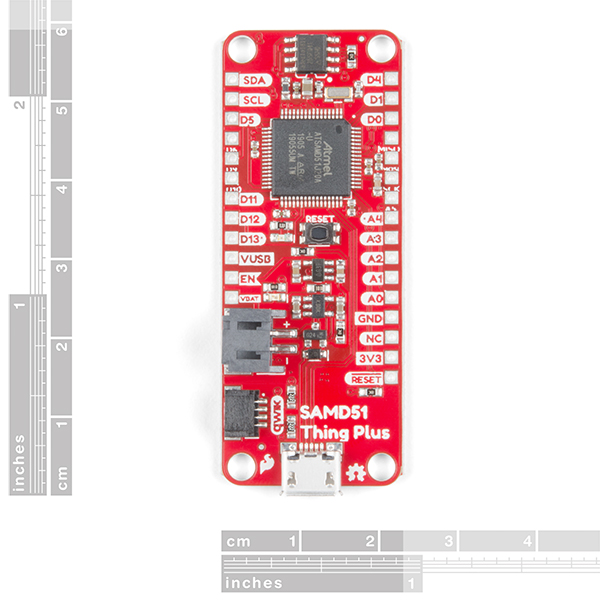SparkFun Thing Plus - SAMD51
Is it power you seek? With a 32-bit ARM Cortex-M4F MCU, the SparkFun SAMD51 Thing Plus is one of our most powerful microcontroller boards yet! The SAMD51 Thing Plus provides you with an economical and easy to use development platform if you're needing more power with minimal working space. This Thing even comes flashed with the same convenient UF2 bootloader as the RedBoard Turbo. To make the Thing Plus even easier to use, we've moved a few pins around to make the board Feather compatible and it utilizes our handy Qwiic Connect System which means no soldering or shields are required to connect it to the rest of your system!
The ATSAMD51J20 utilizes a 32-bit ARM Cortex-M4 processor with Floating Point Unit (FPU), running up to 120MHz, up to 1MB of flash memory, up to 256KB of SRAM with ECC, up to 6 SERCOM interfaces, and other features. In addition to the USB interface and Qwiic connection, a The SAMD51 Thing Plus provides a 600mA 3.3V regulator and LiPo charger.
The SparkFun Qwiic Connect System is an ecosystem of I2C sensors, actuators, shields and cables that make prototyping faster and less prone to error. All Qwiic-enabled boards use a common 1mm pitch, 4-pin JST connector. This reduces the amount of required PCB space, and polarized connections mean you can’t hook it up wrong.
SparkFun Thing Plus - DA16200 Features
- Atmel ATSAMD51J20 MCU
- 21 Multifunctional GPIO Pins:
- Up to six available 12-bit ADC channels
- Up to twenty-one 24-bit PWM outputs
- A single hardware UART
- A single SPI Bus
- A single I2C Bus
- 21 Multifunctional GPIO Pins:
- Thing Plus (or Feather) Form-Factor:
- Dimensions: 2.3" x 0.9"
- Four Mounting Holes:
- 4-40 screw compatible
- 28 PTH Pins
- micro-B USBConnector
- 2-pin JST Connector for a LiPo Battery (not included)
- 4-pin JST Qwiic Connector
- LEDs:
CHG- Yellow battery charging indicatorSTAT- Blue status/test LED (D13)
- Buttons:
Reset
- 4Mb QSPI Flash Memory
- SWD Pins and Test Points
ATSAMD51J20 General Features:
- 32-bit ARM Cortex-M4F MCU
- Up to 120MHz CPU speed
- 1MB flash memory
- 256KB SRAM
- Up to 6 SERCOM interfaces
- UF2 bootloader
SparkFun Thing Plus - SAMD51 Product Help and Resources
SAMD51 Thing Plus Hookup Guide
May 24, 2019
This tutorial covers the basic functionality of the SAMD51 Thing Plus and highlights the features of the new ARM Cortex-M4F development board.
Adding More SERCOM Ports for SAMD Boards
February 4, 2019
How to setup extra SPI, UART, and I2C serial ports on a SAMD-based boards.
SparkFun Qwiic Shield for Thing Plus Hookup Guide
January 30, 2020
A short guide for assembling and using the SparkFun Qwiic Shield for Thing Plus.
Core Skill: Programming
If a board needs code or communicates somehow, you're going to need to know how to program or interface with it. The programming skill is all about communication and code.
Skill Level: Rookie - You will need a better fundamental understand of what code is, and how it works. You will be using beginner-level software and development tools like Arduino. You will be dealing directly with code, but numerous examples and libraries are available. Sensors or shields will communicate with serial or TTL.
See all skill levels
Core Skill: Electrical Prototyping
If it requires power, you need to know how much, what all the pins do, and how to hook it up. You may need to reference datasheets, schematics, and know the ins and outs of electronics.
Skill Level: Rookie - You may be required to know a bit more about the component, such as orientation, or how to hook it up, in addition to power requirements. You will need to understand polarized components.
See all skill levels
Comments
Looking for answers to technical questions?
We welcome your comments and suggestions below. However, if you are looking for solutions to technical questions please see our Technical Assistance page.
Customer Reviews
4.5 out of 5
Based on 2 ratings:
1 of 1 found this helpful:
solid design...stable bootloader
so far...using mac based arduino system...it has been more stable than some adafruit boards...looks like a good "brain" for my design of networked "pods" in a machine design...
Nice toy but...
I managed to toast my first SAMD51 by connecting a battery with a wrong polarization (smokin.... literally). Apart from that a fun toy. Sometimes a bit hard to find suitable libs for some corner cases. General lib coverage is, however, very good.





But how is this a part of Internet of THINGs if it doesn't have WiFi?
It's called a "Thing Plus" because it uses the same footprint as the ESP32 Thing Plus.
Anybody know how to access the real time clock on this "thing?" The RTCZero library does not seem to work.
External flash memory is way-smaller than advertised! The included Adesto AT25SF041 serial flash is only 512KB, but your "Hookup Guide" and the "Hardware Overview" advertises flash size as 4MB, this is incorrect, actual size is 512KB (or 4Mbit).
Please note error in documentation.
Looks like the graphical data sheet is broken (nine of the labels are showing up).
Is it possible to run TensorFlow Lite in SparkFun Thing Plus - SAMD51?
How do I access the memory to store data?
Just discovered this board. Looks really interesting, though a couple of issues 1) It can't measure the voltage on the LiIon 2) I can't hook up an external Vref. Great to see the LiIon chg at 0.5A (though be areally to manage it based on USB(C) connection), 4M flash Eeprom.
It looks like the only way to access the SWDIO and SWCLK signals is through a small surface mount test point. That would seem to make this board a no-go for anyone wanting to develop on it and use a debugger like a JLink, STlink, BlackMagic Probe, etc.
Its a little tricky, but you can still solder to those test points if needed.
@Santa Claus Impersonator: Thanks for fixing the documentation links. There are still several points of confusion for me as a new user of this board. The chip has so much flexibility it leaves me somewhat muddled. Programming through the Linux version of the Arduino IDE (1.89) using the default variant.cpp file it seems that the async port known as 'Serial1' corresponds to the D1 & D0 pins. The compiler does not recognize 'SerialUSB' as on the SAMD21 Pro RF, but opening & writing to just 'Serial' appears to send output to the onboard USB connector which appears in Linux as some variant of /dev/ttyACM[x]. Is this correct?
It sounds like you might be looking for technical assistance. Please use the link in the banner above, to get started with posting a topic in our forums. Our technical support team will do their best to assist you.
Otherwise, that is correct,
Serial1refers to the the hardware pin serial connection andSerialrefers to the USB connection. In the Arduino IDE, the built-in Examples>Communication>SerialPassthrough example explains it more clearly. It depends on your flavor of Linux for the name of the serial port, but yes... any information onSerialshould pass through the USB connection of the computer and is what you would normally interact with through the Serial Monitor of the Arduino IDE.Where is the datasheet and the Graphical datasheet? Links: https://cdn.sparkfun.com/assets/c/a/8/6/8/ThingPlusSamD51a.pdf and https://cdn.sparkfun.com/assets/0/0/5/9/2/60001507C.pdf are dead as rocks!
I replaced the files, the links should be working now.
Sorry about that. We had a server outage the other day... I'll follow up with our IT team to get the links fixed.
Nice board! Love the Feather compatibility. But it seems even harder for old fingers to get the bootloader right than the SAMD21's!
amazing little board!!
I started to checkout, but when i got to the shipping prices... Holy cow, its messed up. Ok, so if i wanted to choose 3-11, that price is fair. But what a gap in time. 1-5, so i could pay more, but the 3-11 days falls within 1-5. makes no sense. 2 day is $21 & next is $28. Are those prices for the rich and famous only? For how much product you ship, you should really have a better strategy laid out.
Next Business Day $28.96 2 Business Days $21.88 1-5 Business Days $13.36\ 3-11 Business Days $6.67
Thank you for your feedback, we are constantly working to get better shipping prices and improve customer experience. As for the 1-5 vs the 3-11, those are 2 different methods as defined by FedEx, we've just chosen to not list them by name but by time frame which makes more sense to people, but I understand how it can be confusing. I will pass along your concerns and thanks again for your feedback.
Link to the Hookup Guide is broken. 404 error
It should be working now.
Description says 6 SERCOMs, Features says 8, and the video says 8. Which is correct?
Should be 6 SERCOMs. We've fixed the Features tab accordingly--thank you for pointing this out!
Is it really an 8-bit AVR microcontroller? It says that it's a 32-bit ARM, and searching for AVR in the datasheet returns no hits.
Also, the link to the hookup guide leads to a 404 site.
We've fixed the description and hookup guide link--thank you for catching that.
This seems like a bad deal on all fronts compared with the ESP32 Thing, which has more memory/storage and WiFi and BTLE, at the same price. (Also, how can you call this an “8-bit AVR microcontroller” when it has a 32-bit ARM CPU?)